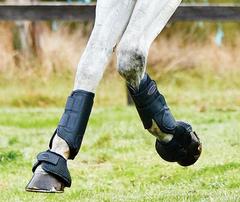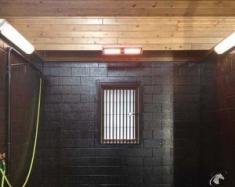
George Morris Clinic
It’s time to start thinking about show season again. To get you and your horse in shape for the discipline you choose, consider going to ride in a clinic this year. Clinics are great chances to learn under skilled trainers and riders, but riding in your first clinic can be a bit intimidating. Planning ahead of time can ensure that you and your horse are ready to go on the day of the clinic.
Research the Clinician
Clinicians are all individuals, and because of this each clinician’s clinics are run a little bit differently. Find out about the clinician’s prior clinics. What were they like? How were riders and horses turned out? Does the clinician have a standard form in which clinics are run – for instance, focusing on groundwork in the morning and riding in the afternoon?
Learning about the clinician’s teaching methods can help you to prepare yourself, too. If the clinician has books or videos available, use them to give yourself a foundation on which you can build during the clinic. Understanding the clinician’s methods of teaching can also help prepare you for what you can expect on the day of the clinic.
Finally, have a clear idea of what you want to work on. If flying changes are an issue, but only on the right, let the clinician know so she can focus on it. Don’t make the clinician “guess” what you need to improve.
Find Out About the Dress Code
The turnout expected of horses and riders varies widely from clinic to clinic. Find out about the desired dress code for your clinic, and then make sure that you and your horse are ready to fit that dress code. Regardless of the specifics of any clinic, you should always make sure that both you and your horse are polished. Put effort into your appearance, and be sure to clean your tack and use clean saddle pads and leg wraps.
Keep Yourselves Fit
Clinics can demand a lot of a horse – and a lot of you. It isn’t fair to expect your horse to participate in a multi-hour clinic if you only ride him a few hours a week. Spend time building up your horse’s condition, and yours as well, especially if you know that the clinic will be athletically intense.
As you work with your horse, touch on the basics that you will be working on in the clinic, but don’t drill him on the particular issues. Remember, a clinic is meant to help a horse and rider improve. You and your horse can be less than perfect on clinic day; the idea is that when you leave, you’ll leave with new knowledge and improvement.
Do your homework when choosing and preparing for a clinic, but once the day arrives, relax and have a great time learning with your horse. And listen to what the clinician says – they have alot of experience and you paid them to teach you.
 If you are looking for a new horse, especially if you’d like to have the unique, consider the Hackney Pony. This flashy, high-stepping pony has an intriguing history and makes a popular horse show competitor.
If you are looking for a new horse, especially if you’d like to have the unique, consider the Hackney Pony. This flashy, high-stepping pony has an intriguing history and makes a popular horse show competitor. Spring is finally here (or at least almost here…)! For riders, spring means many things – some of them good, some of them not so great. Here are some of the things that we love – and hate – about spring!
Spring is finally here (or at least almost here…)! For riders, spring means many things – some of them good, some of them not so great. Here are some of the things that we love – and hate – about spring! One of the best ways to succeed jumping at a show is to get your horse as familiar as possible with a variety of jumps in the safety of your own arena. Most jumps at shows are fairly straightforward – vertical and oxer. What so often scares horses are the bright colors, flags, flowers and other design elements.
One of the best ways to succeed jumping at a show is to get your horse as familiar as possible with a variety of jumps in the safety of your own arena. Most jumps at shows are fairly straightforward – vertical and oxer. What so often scares horses are the bright colors, flags, flowers and other design elements.  With the Irish celebration of St. Patrick’s Day just a few days from now, here is one of the many Celtic legends that include the horse. Thank to “Symbolic Horse Education Resources” for the information.
With the Irish celebration of St. Patrick’s Day just a few days from now, here is one of the many Celtic legends that include the horse. Thank to “Symbolic Horse Education Resources” for the information.
 Whether you are building a new barn or renovating an old one, the best way to get the barn you want is to remember the old adage, “form follows function.” There are so many options for both the outside and the inside of your dream barn that you’ll have little trouble putting together the barn that’s right for you and your horses. But before you start planning your barn, think about the following things:
Whether you are building a new barn or renovating an old one, the best way to get the barn you want is to remember the old adage, “form follows function.” There are so many options for both the outside and the inside of your dream barn that you’ll have little trouble putting together the barn that’s right for you and your horses. But before you start planning your barn, think about the following things: One of your toughest decisions – but many people feel the most fun – you’ll make when building your barn is the style. There are many to choose from and each style can have modifications. Things to consider are the style’s suitability to your climate, the function or “flow” of your horse
One of your toughest decisions – but many people feel the most fun – you’ll make when building your barn is the style. There are many to choose from and each style can have modifications. Things to consider are the style’s suitability to your climate, the function or “flow” of your horse  work and, of course, your budget. The amount of
work and, of course, your budget. The amount of  You’ve probably noticed that some horses wear boots or bandages on their lower legs when ridden. Although they can provide some minimal support to the horse’s tendons and ligaments, boots and bandages are primarily used for protection of the horse from himself. If you want to use something on your horse’s legs, it can be confusing to figure out what to use and when.
You’ve probably noticed that some horses wear boots or bandages on their lower legs when ridden. Although they can provide some minimal support to the horse’s tendons and ligaments, boots and bandages are primarily used for protection of the horse from himself. If you want to use something on your horse’s legs, it can be confusing to figure out what to use and when. Having a safe and functional wash bay is an essential element of any barn It can be outside or inside, though of course most would prefer inside. Here are some ideas to consider when building or upgrading your wash area.
Having a safe and functional wash bay is an essential element of any barn It can be outside or inside, though of course most would prefer inside. Here are some ideas to consider when building or upgrading your wash area.